Operation "Cheese"
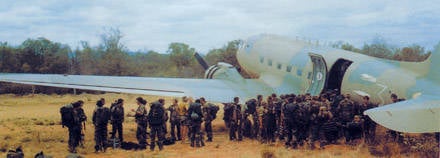
The most important section of this communication was the largest railway bridge across the Chambeshi River, in the north-eastern part of Zambia - the longest bridge on this railway. Approximately half a kilometer from him, there was a bridge for motor transport - it also played an important role in the transport infrastructure of Zambia: in particular, transit of cement and oil products to Burundi went through it.
All this information was collected in advance in the dossier - but the materials remained for the time being just developments. In the summer of 1978, the Rhodesian SED was tasked with destroying bridges, and operatives began to develop the operation. But as is often the case, the order to cancel was soon received - at the top they decided that, for some reasons, the action could not be held. The fact that Rhodesia still struck deliberately terrorist objects, and not economically important, played its role. The development of the operation, much to the displeasure of the SAS command, had to be curtailed.
But a year later, at the very beginning of September 1979, the “good” unexpectedly arrived from above. It is difficult to say why this time was chosen - the fate of Rhodesia was actually predetermined: soon a conference on the final solution of the “Rhodesian question” was to begin in London, after which a new government would come to power again. But the Rhodesians did not intend to give up. Fortunately, preliminary calculations have already been made, so the operation, which received the code name "Cheese", began almost immediately.
Literally from the very first minute, the direct performers realized that the task facing them was described in one word - “impossible”. The main problem was the distance. The targets were located at a distance of more than 300 kilometers from the border with Rhodesia (and more than 700 kilometers from the Kabrit camp, the main base of the CAC). Thus, the bridges across the Chambesh were the most distant target for the entire history special operations of Rhodesia. Accordingly, the risk that everything will go wrong has increased many times.
Questions related to the operation multiplied with every minute: what can be said about the situation and condition of the local population in the territory adjacent to the target? How close are the settlements to the bridge and what are they? Is the bridge safeguarded? How numerous are the police forces in the area? Etc. And the most important question - how will the group leave after the bridges are destroyed? Since after the blast, the authorities are likely to immediately announce the alarm and begin the search — and the border will be very, very far.
The first step was to find out how well the bridges are guarded and what is the situation with the local population. Since SAS did not have accurate operational data, it was necessary to resort to the help of colleagues from intelligence. One of the agents came to Zambia and drove around the area by car, collecting the necessary information. According to him, there was a small police post not far from the bridges, and as for the population, it lived more or less evenly along both banks of Chambesh along the entire length of the river.
Delivery of saboteurs to the target by land transport and from helicopters was excluded. There was only one way out - night parachute assault. The penetration was planned in two stages. First, a group of four operatives is landed with a long jump - they carry out reconnaissance of the area and assess the level of presence of the police and armed forces. Then the main group of 12 people is parachuted. Then all 16 sasovtsev canoeing
swim to the bridges.
The main group took with them a ton of explosives, a rubber boat “Zodiac” with an outboard motor and several canoes. The load was huge - and during the training sessions, most of the time was spent on learning how to lay it carefully and compactly.
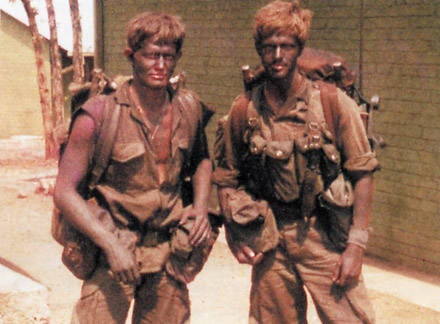
Purpose
The task set by the command was formulated very clearly: the bridges should not just be blown up, but put out of action for the maximum period (preferably, of course, without the possibility of restoration). To achieve the desired effect, part of the charges must be exploded under water. In addition, during the operation, in addition to standard explosive charges, it was decided to use experimental explosive equipment: a disruptive network. It was supposed to be used to undermine the railway bridge - the main target of sabotage. On the one side of the central pillar of the bridge (the most voluminous of the three), the bombers intended to install three explosive charges of 100 kilograms each under water. On the opposite side, a subversive network was attached - its charges had to detonate in a fraction of a second before the main ones worked. A preemptive explosion momentarily displaces water - as a result, an airbag is formed on one side of the truss. Then the main charges are triggered - and since at that moment there will be no water resistance from the opposite side, then the support, in accordance with the laws of physics, will break in half.
As for the methods of withdrawal, among other things it was assumed that the special forces were landing the Land Rover. Alas, after several attempts this idea had to be abandoned. In the end, the command agreed that after the explosion, the operatives would seize the car and drive it to the south of the country. At the same time, it turned out that on the way back, the Sasovans could not keep away from the cities of Chambesh and Mpik. Maps of the area were unreliable — firstly, outdated, and secondly, large-scale.
The success of the evacuation after the blast depended only on how soon the saboteurs would be able to find the right car. If they succeed, then everything should end normally. If not, then operatives, to put it mildly, had very serious problems.
Failed landing
October 3 in 22.00 plane with a forward reconnaissance group took off and headed for Zambia. On approaching the area where the bridges were located, the paratroopers stood in anticipation of the team. Four paratroopers, loaded like camels in a caravan, headed for the door. A minute later, the saboteurs, along with an additional load of equipment, jumped into the night, from a height of four kilometers. After spending a minute in free fall, they opened their parachutes and sent them to the landing site. Cargo parachutes opened forcibly at a given height. Having gathered after the landing, the investigators, to the great relief, found out that all four were alive and well, but a nuisance happened: one of the cargo parachutes did not open. This meant that the cargo fell somewhere in the bush, and now there are two canoes, spare parts and other equipment. And without a canoe, the saboteurs could not get to the bridges to perform additional exploration on the spot. In addition, along with the canoe, the radio station also disappeared. Again, fortunately, the senior group Dave Dodson was smart enough to insist in advance that one of the intelligence officers should carry a spare kit. All night and half the next day the investigators spent searching for the missing equipment. Towards evening, Dodson decided that further searches were meaningless, and turned them down.
Do not give up and do not give up!
Such a beginning any sensible person would consider a bad omen. Dodson, in general, held the same opinion, but even less did he want to stop the whole operation. He decided to reach the bridges on foot. This, of course, was much more difficult than canoeing on the river, and significantly reduced the total time of the entire operation - but still better than nothing. He contacted the SAS headquarters and informed the command of his plan, also asking the main group to include everything that was missing in the equipment list.
at the first landing.
Two and a half days later, four tired operatives came to a tributary of the Chambesh River. Leaving one of the special forces on guard, Major Dodson, Lieutenant Phil Brooke and Junior Corporal Andy Standish-Whitey undressed and sailed to the bridges. Having reached the structures, they were relieved to find that the territory adjacent to the bridges was virtually deserted, with the exception of a single guard on the bridge. The width of Chambeshi in this place was no more than 200, the depth was about 4 meters. The size of the bridges turned out to be exactly the ones that were presented by expert analysts after the processing of aerial intelligence data. After that, the saboteurs sailed back to the place where the fourth member of the group was waiting for them.
They made their way back to the landing site faster - in general, the journey to the bridges and back took them four days, during which they traveled a total of about 100 kilometers. The scouts even had time to get some rest before the arrival of the main group, which carried with it explosives and canoes.
Sudden problem
At one o'clock in the morning on October 8, twelve SAS operatives safely landed from a height of approximately 300 meters and landed without incident at the intended place, where they were met by the advance party. Before sunrise, the special forces hid parachutes and repackaged equipment. After the explosives and canoes were safely hidden in the bush, the operatives went to bed. Morning passed without incident. Some time later in the afternoon, the sentries spotted smoke from a fire in the bush - but it was so far away that it posed no threat. The commandos continued to rest, gaining strength before the upcoming task.
With the onset of darkness, the saboteurs proceeded to the first stage - it was necessary to drag a ton of explosives, six canoes, a rubber boat, a motor, fuel, and their equipment to 400 meters, to the river bank. For a couple of hours, 16 people did just that, dropping back and forth. Despite the fact that they were all strong, healthy and strong, they were so exhausted that Dodson announced an 30-minute halt before starting to collect the boats and load into them.
It was originally planned that six canoes would take an 12 man and as much equipment as possible. A rubber boat with a motor will carry on itself 4 fighters and the main part of the explosives. By the time the special forces were ready for rafting, it was midnight. According to the initial calculations at this time, they should have already been halfway to the bridges.
According to photographs of the river, experts determined that the current in this place should not exceed 6 nodes or 11 km / h. Since the advance team, due to the loss of the canoe, could not verify how expert the conclusions were true, no one knew exactly how strong the flow was. The answer came as soon as the saboteurs tried to get under way.
The operatives very quickly realized that there was no talk of any 6 nodes - rather, 15 nodes, that is, 27 km / h. Moreover, on the river, as it turned out unexpectedly, thresholds, pitfalls and hippos began to fall in abundance. Even the 11-kilowatt outboard motor on the Zodiac could not cope with its task. Scouts from the advanced group began to reach that even if they had not lost the canoe, they would still have to spend as much time to get to the bridges along the river and raft back.
Those who were in a canoe envied those who were sitting in a motorboat. Those who sat in the boat thought that those who were in canoes with lucky little boats, successfully maneuvering, passed through the rapids with little effort. But Bob Mackenzie and his three comrades in the "Zodiac" had a hard time - the boat was loaded to the maximum, sat low and moved very hard. She now and then carried to the shore, and the motor from time to time clinging stones.
It was obvious to everyone that the initial timing of the time was somewhat presumptuous, and the saboteurs would not have time to reach the goal the next day. God forbid, if it takes two, if not three days. The operatives could not sail around the clock - during the day they were forced to hide in the undergrowth to avoid the attention of the local population living along the river banks. The flow on the river was much stronger than everyone expected.
Overwhelming difficulties
At one of the rapids to the limit, the exhausted Zodiac crew lost control at one moment, and the boat was blown over by the current, a couple of hundred meters, almost knocking over. They tried again to pass this threshold, but with the same result. Then Mackenzie decided to donate part of the goods. With such a load, the boat was powerless to overcome the threshold. So Mackenzie was forced to knock over the 150 kilograms of explosives overboard - this automatically meant that one of the bridge supports would remain intact. There was no other alternative. But, even getting rid of part of the explosives, they overcame the threshold with great difficulty.
The difficulties are not over. It cost the crew of the Zodiac to cross the ill-fated threshold and swim a little further, as the outboard motor stalled and did not respond to all attempts to bring it back to life. The reason turned out almost immediately - water got into one of the fuel canisters, and when fuel was poured into the engine, the water “blocked” the carburetor.
Bob and his group began to demolish downstream. They were finally able to scoop up to the shore and get on the joke. Bob understood that if they somehow miraculously did not repair this motor, then the operation would have to be curtailed.
Meanwhile, Dave Dodson and the rest of the saboteurs rowed on, unaware of what happened to the Mackenzie crew. Fortunately, the Rhodesian SED was selected not only for its physical qualities, but also for how quickly a person can adapt to an extreme situation and resolve it. Sergeant "Vossi" Voslo, by the light of a flashlight, managed to disassemble the engine, clean the carburetor, and assemble the engine again. The Zodiac was on the move again, but the crew was half an hour behind its comrades. Nevertheless, Bob and his group managed to catch up with them.
Finally, on the night of October 10, the group approached the bridges. The commandos were close enough to hear the noise of trains on the Tazar railway and the passage of vehicles on a nearby bridge. The group found a cluster of dense thickets a couple of kilometers from the bridges and lay down for a day.
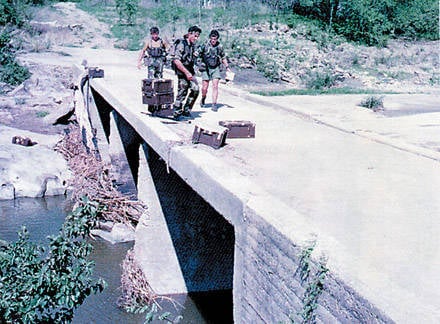
Mining
With the onset of darkness 12 saboteurs on six canoes sailed to the bridges. Bob Mackenzie and three of his colleagues in the Zodiac with explosives were supposed to follow the main group some time later. Two canoes with saboteurs headed for the coast — it was a subgroup that combined the functions of attack and support. She, acting on land, was responsible for identifying and neutralizing protection, warning the main group about the occurrence of unforeseen circumstances and ensuring security during an enemy attack.
Two other crews moored to the middle support of the railway bridge and began to tie it up with a cable so that a rubber boat with an explosives could moor to it. Another 4 man began to strengthen the hooks on the same pedestal, in order to hang three hundred kilogram charges of explosives.
When the "Zodiac" with the Mackenzie group reached the bridge, the main group had already completed its work: the hooks were secured, and a cable was tied around the truss. After that, moored to the support, the Rhodesians began to unload explosives. The charges were raised on the ropes, using hooks as blocks, and then gently lowered into the water. Then the special forces began to establish this experimental subversive network on the opposite side of the farm. But it was heavy, so while it was installed, until it was fixed in the right place, so that it would not be demolished by the flow, until it was checked that everything was correct, time passed. After that, they strengthened the igniter cords on the charges, so that at the last moment to connect them into a ring circuit.
Suddenly, on the shore there were the sounds of gunfire. Sasovtsy froze. Shooting no longer followed, and the saboteurs continued their work. Later it turned out that, to his misfortune, a policeman appeared in the area. Seeing armed Phil Brooke and Frank Booth, he aimed his shotgun at them and demanded an explanation of what they were doing here at such an inappropriate time. Then, apparently realizing that there was nothing good, he tried to open fire and received in response short lines from the AK-47 with a silencer. He managed to escape, but not far - he died from his wounds.
The mining of bridges continued, and each of the saboteurs was busy with their own business.
At the same time, Lieutenant Brooke and his subordinates began preparing the group for departure. Phil and his group blocked the highway, deploying a “portable gearbox” on it. This element of the plan was the key to capture the machine. Prepared for this carefully - the group took with it exact copies of Zambian traffic signs and police barriers. The trick worked - the cars that by this time began to appear on the highway, slowed down, stopped and then drove on at the command of the fake "Zambian police." The intensity of the movement was average - the morning had not yet arrived, and the stream of cars was interrupted from time to time. The Rhodesians were ready for such a turn of events, and coped well with the role of road police, regulating traffic and portraying activity. Nevertheless, for the time being, there was no suitable vehicle that could have been taken on board by an 16 man with equipment.
The rest of the group continued to mine bridges. Since the saboteurs were under the bridge, they were not visible from above - and the activity of the special forces remained outside the sphere of attention of passing drivers. Part continued to check and recheck the installation of charges, others disassembled and folded equipment. Dodson on the radio tracked all the activities of subordinates. Thanks to the numerous training sessions conducted at the facilities in Rhodesia, everything went according to plan. Finally, all the charges on the railway bridge were connected to one network and connected to the same network on the highway, forming a single subversive network.
Vehicle problems
Time began to tighten, but Brooke still could not find a suitable transport. Dodson coped with the subordinate's radio how he was doing, making it clear that it was undesirable to delay this part of the operation. At the entrance to the bridge, a small traffic jam began to accumulate - the cars slowed down at the checkpoint, but Brooke frantically waved drivers to pass without stopping. Finally, a twenty-ton truck with a load of mineral fertilizers appeared on the road, and Phil realized that this was what was needed.
The truck stopped at an improvised checkpoint, and Brooke signs the driver to pull over. The white driver and his partner, an African, got out of the cab and were immediately taken into custody. The alleged police officers quickly installed signs indicating that the car had crashed, and the checkpoints and police signs, on the contrary, were removed. Hope was that the drivers, seeing the "police", stopped the car and signs, reporting about the accident, will pass without stopping. However, life immediately made its own adjustments.
Next to the "broken" truck stopped another. The white driver came up to the “broken” car and began offering his help. I had to take him into custody. A few minutes later another truck appeared, one of those that drove earlier. It turns out that the driver of the third truck, also white, found that the car with fertilizers that followed it was lost somewhere, turned around
and drove back.
At about that time, Bob Mackenzie, who had finished helping the minerals on the road bridge, took a couple of people with him and went to see if his “policemen” needed help. When they got closer, they saw two trucks parked at the curb, a returning third truck. In addition, from the opposite side the fourth approached them. The situation at any moment threatened to turn into a traffic jam. But the driver of the fourth truck, seeing the men armed with machine guns, added gas. But the driver of the returning truck, on the contrary, considered that he had to intervene, and stubbornly refused to leave. He said that without a truck driver with fertilizers, he would not move anywhere.
Then it came to the special forces that the two trucks were driving together in one column, and moreover, the drivers were brothers. Sasovtsy unsuccessfully tried to convince the driver that he would have better to leave, but he turned out to be stubborn and insisted that without a brother he would not think to get under way. As a result, he had to be taken into custody. As it turned out later, at that time there were only six white truck drivers in the whole of Zambia - and exactly half of them were captured by CAC!
Problems grow
But drivers were just the beginning of the problem. In addition to adult men, the Rhodesians were “in captivity” and there was an 10-year-old boy, the son of one of the drivers. Butch Shawn took his son Neil on this trip to make a birthday present for the child - drive through the whole country in a big truck. The gift was a success for all 100 percent - neither father, nor son, nor Neil’s uncle, Mike (another driver) could have even foreseen such a turn of events.
When Dodson learned about the detention of several prisoners, he became enraged. Coldly asking Brooke if he was aware of his actions, the major ordered to bring the detainees to him. Dodson did not expect everything to go this way. Now I had to decide what to do next. If you take the prisoners with you back to Rhodesia, this will create a lot of problems. On the other hand, if you let them go, then they waste no time in raising the alarm. And, considering how far from the border were the Sasovans, the prospect of getting the surrounding Zambian garrisons, the Air Force, the police and the unfriendly population to the saboteurs clearly did not smile.
The order of the headquarters categorically read: “The operation, under no circumstances, should not be“ illuminated ””! Not a single soul in Zambia should know who blew up the bridges. As a result, Dodson decided that they would take the prisoners with them, and the problems could be solved later. Not the most optimal solution, but there were no alternatives for the special forces.
Before the track ...
While the commander puzzled over how to deal with prisoners, the saboteurs were finishing the main stage of the operation. The canoes were disassembled and packed, the Zodiac was rolled up, equipment was carried to the road, the last charges were installed on the railway bridge. A group of trucks equipped future transport - bags of fertilizer from the truck were thrown out and hidden in the bushes. By car, they left only those bags that closed the perimeter - thus, in the open body, an improvised “fort” was obtained, in which soldiers could hide.
Two miners connected all the charges in a single chain, and the remaining special forces loaded the boats and the rest of the equipment into the truck. Mike and Butch Shawney climbed into the cabin. Dodson settled behind the brothers, holding a pistol with a silencer in his hand - the hint was obvious. Mike gave the car to the south end of the bridge, ready on the order to set off. It only remained to set fire to the igniter cord. The incend tubes provided a fifteen minute delay, which enabled the group to retire to a safe distance. Disruptive networks have been duplicated and repeatedly tested to ensure the reliability of the disruption.
The miners set fire to the cords and ran across the bridge to the truck, where their colleagues were waiting. The watch was 02.15, and Dave Dodson ordered Mike Shawn to touch. The noticeably nervous driver obeyed, and the car drove south. Both Mike and his brother Butch asked to be kept alive. Dodson eventually was able to convince them that as long as they drove the car, they were not in danger.
When the truck with the whole crew on board approached the town of Chambesh, the brothers, without saying a word, told Dodson that there was a small police station in the city. Fortunately, at that hour, no lights were on in his windows, and the car reached the outskirts of Chambesh without incident.
20 kilometers from Dodson Bridge order Mike Shawn to stop. A couple of saboteurs, leaving the truck, cut the telephone and telegraph wires in all directions. At that moment, when they were finishing to put the connection into disrepair, everyone saw in the distance a huge orange flash. After some time, the explosion went off. In the first second the Susovs could not even believe that everything had finally worked.
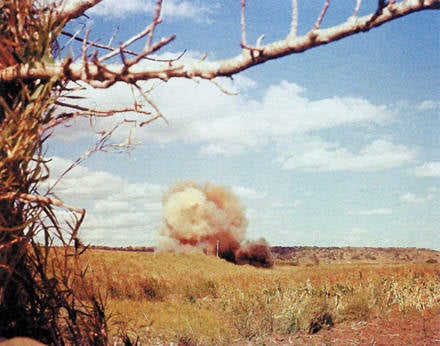
It's time to blow your feet
Unfortunately, they could not return to the place of sabotage and look at the destruction - now the time factor has become critical, and it was time to take the legs. They admitted the likelihood that one of the drivers passing through the fake checkpoint could later report to the police. In addition, the saboteurs had to pass Mpiku, the city where the police were, on their way, and it would have been better to do this before dawn. Judging by the map, the road did not enter the city, but went around it, but Dodson was not sure exactly the map. Fortunately, Mike, who was driving, chose the right route, and they didn’t come to Mpiku. After that, they could only go forward, until the sun rises above the horizon.
In these early morning hours, there were quite a few cars on the highway, but none of the drivers paid any attention to the truck. It simply did not occur to them that there were six prisoners in the car and sixteen CAC saboteurs of Rhodesia who had just dealt a considerable blow to the Zambian economy.
Bridges of Khan!
When it became clear that it was about to dawn, Dodson ordered the driver to take a side road where they could wait out the day. He hoped to settle for a day somewhere near the town of Serendzhe, the road from which led to the south, to the national park-reserve "South Luangwa".
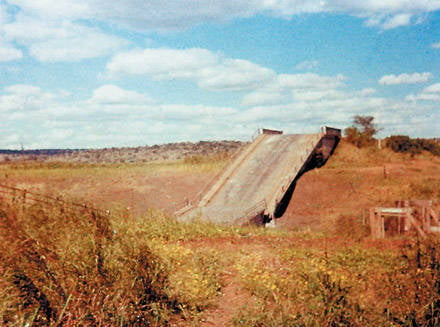
Bob Mackenzie moved into the cab of the truck to Dodson to help navigate and read the map; In addition, Butch replaced his brother behind the wheel of a truck. Dawn found the special forces and their captives right in the middle of the vast territory of the tribal agreements - the so-called territories in Rhodesia and Zambia, set aside by the government for the tribes to live. For one and a half hours, they drove through fairly populated areas, followed by the gaze of hundreds, if not thousands, of people. Both Mackenzie and Dodson were still made up - their faces and hands were smeared with camouflage cream. This gave some chance that they could be taken from afar as Africans, but of course there was no guarantee. Nevertheless, Zambians fun waved after the truck, and no one suspected that the Rhodesians, sitting in the cab, were white. Mackenzie and Dodson waved briskly back, silently wondering at their luck.
Around this time, a short message literally arrived from the pilots of the Rhodesian Air Force who overflew the sabotage site: “To the bridges of the khan - they are blown up!”. The task has been completed.
Sudden delay
The Rhodesians had already been driving along the country road for several hours and were sure that they had lost more than enough from their possible pursuers - it would have been extremely difficult to detect the group without involving the Air Force. But life has once again refuted all plans. Having crossed a small hill, they saw in the distance a rather large power station, standing alone in the middle of the savanna. The only plus was that when he saw the station, Mackenzie was able to attach his map to the terrain and determine the exact position. Everything else in their situation was a drawback, the most important of which was the guard, since it was 100% at the station. Dodson ordered the driver to stop. The fighters and prisoners came out of the body and brewed tea, and the commander and his deputy began to confer, trying to figure out how to do better.
Sasovtsy did not know that the station security had already noticed them. While the commanders conferred, and the subordinates and prisoners rested, the guards decided to go and find out what was needed in these parts of a lonely truck with a large number of people. At about 10 hours, the Rhodesians heard the noise of an approaching car. The operatives immediately crumbled, occupied the defenses around the truck and prepared for a possible attack. From the approached "Land Rover" came out six Africans in uniform. One of the Sasovans, still disguised as an African, went to meet them, hoping to lure them closer in order to capture them. But the guards suspected that something was wrong, and, after making a couple of shots, they turned around and ran away. The commandos opened fire, and four of the six guards were left lying on the ground.
After such a noise, the sasovtsam had no choice but to get out of there quickly. Dodson decided to go straight through the bush, heading south.
We ask for evacuation!
By the end of the day, the terrain they traveled on became so rugged that there was no way to move further. But by that time they were so close to the border with Rhodesia that they could call helicopters. According to Mackenzie, they were separated from the border about 200 kilometers - which fit into the range of the “birdies” of the 8 squadron. Sasovtsy contacted the headquarters, but the evacuation was postponed the next morning - it was night, and sending helicopters would be too risky. The saboteurs were told to wait for the next day’s evacuation by 8.00.
The rest of the day the soldiers spent clearing a place for landing helicopters. This was followed by a short dinner - the special forces shared their meager rations with captives (traditional tea), and everyone went to bed. After some minutes, the entire camp, except for the guards, was sleeping deeply - everyone was exhausted to the limit.
As soon as the helicopters appeared in the distance, the driver brothers became nervous again. In spite of the fact that almost everyone promised them that no hair would fall from their heads, the Shawns decided that now they would be accurately slapped between the eyes and thrown into the bush. Only when they were almost driven by the butts to the helicopters, they calmed down.
Helicopters headed for Rhodesia — across the Luangwa River, across the Great Eastern Road — the main thoroughfare in Zambia, through Mozambique and Kabora-Bassa Lake, and finally landed in the Mission Mission. There they once again refueled and took to the air to deliver the Sasovans to the Kabrit camp.
The operatives reported to the command about the completion of the task, after which they cleaned themselves up and headed home. As for the captives, they had some time to be guests of the special service of Rhodesia.
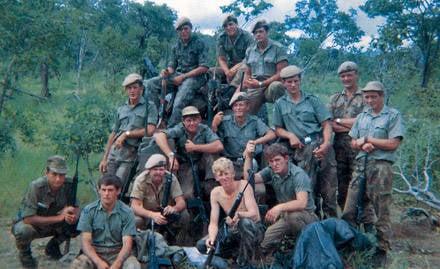
Economic sabotage
As for the reaction of official Lusaka, it was predictable. In his speech, President Kenneth Kaunda called the incident "an economic sabotage that undermines the country's economy." The grounds were: 18 thousands of tons of goods needed by Zambia, including maize, in which Zambia was deficient, were stuck in Dar es Salaam. At the same time, 10 thousand tons of copper, the main export item of Zambia, were locked inside the country.
The hopes of Zambia to provide themselves with food the following year collapsed along with the undermined bridges. Due to severe drought and inadequate delivery of fertilizers, the maize harvest was negligible, and there were no stocks in the country. According to the estimates of engineers, it would take at least six months to restore the railway bridge and three months to transport it. The cost of the restoration work, according to the most modest estimates, was approximately six million Kwaca Not having that kind of money, Zambia asked for help from the EEC.
The Rhodesians achieved their goal. Bringing bridges to Chambesh, they forced Kaunda to negotiate with the regime he hated, open the borders completely and let cargo flows in a southerly direction, which was beneficial to Rhodesia.
- Sergey KARAMAEV
- http://www.bratishka.ru"rel =" nofollow ">http://www.bratishka.ru
Information